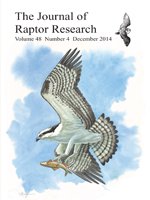The migratory subspecies of the “American” Osprey (Pandion haliaetus carolinensis) breeds across most of North America. Most of these Ospreys winter north of the equator, although significant numbers travel farther south, reaching Argentina. The number of Osprey sightings in Argentina has increased since the first review of their status in this country. We analyzed records of Osprey migration and distribution in Argentina from 1993 to 2008. We found that Ospreys occur year-round in Argentina, with a higher concentration in spring to summer (1 October to 31 March). Our data confirmed that in northern and northeastern Argentina, Ospreys use river systems and their major tributaries, and in central and northwestern regions, they commonly frequent reservoirs. The apparent increase in the number of Osprey records in Argentina in the last decades may result from an actual population increase but may also reflect a larger number of observers. Recent records suggest that Osprey should be considered a regular visitor to northern Argentina. We confirm the importance of northeastern rivers, and central and northwestern reservoirs as wintering areas. Argentina has been noted as an important wintering area for many migratory birds, but has been underestimated as a wintering area for Osprey.
La subespecie migratoria Pandion haliaetus carolinensis se reproduce a través de la mayor parte de América del Norte. La mayoría de estos individuos invernan al norte del Ecuador, aunque números significativos de individuos de esta especie viajan más hacia el sur, llegando a Argentina. El número de avistamientos de individuos de P. h. carolinensis en Argentina ha aumentado desde la primera revisión de su estatus en dicho país. Analizamos los registros de migración y de distribución de P. h. carolinensis en Argentina desde 1993 hasta 2008. Encontramos que los individuos de esta especie se pueden observar todo el año en Argentina, con una mayor concentración en primavera y verano (primero de octubre a 31 de marzo). Nuestros datos confirmaron que en el norte y el noreste de Argentina, P. h. carolinensis utiliza sistemas riparios y sus tributarios mayores, mientras que en las regiones centrales y del noroeste comúnmente frecuentan embalses. El incremento aparente en los registros de individuos de P. h. carolinensis en las últimas décadas puede ser el resultado de un incremento poblacional real pero también puede reflejar un mayor número de observadores. Los registros recientes sugieren que P. h. carolinensis debería ser considerada como un visitante regular del norte de Argentina. Confirmamos la importancia de los ríos del noreste y de los embalses del centro y noroeste como áreas de invernada. Argentina ha sido destacada como un área importante de invernada para muchas especies de aves migratorias, pero ha sido subestimada como un área de invernada para P. h. carolinensis.





